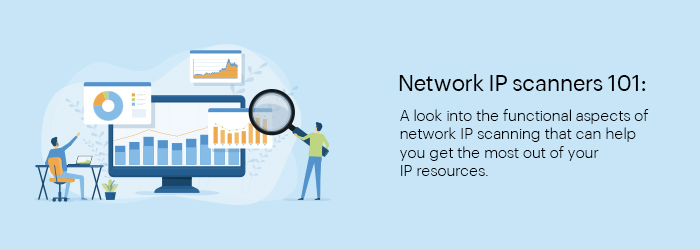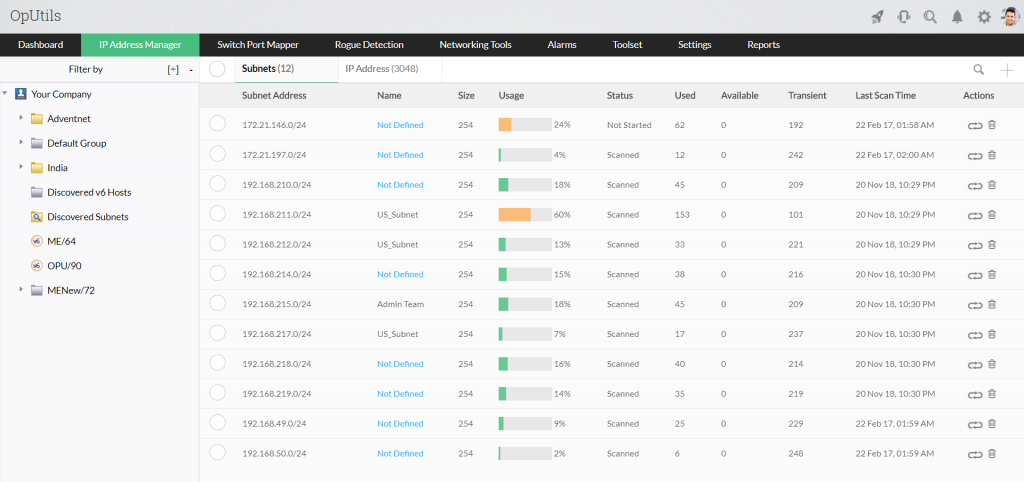
A simple command-line interface (CLI) ping will give you details about your target IP address. However, you may have to input the ipconfig command, and then the arp-a command to fully discover the status of an IP, and this is just for one IP address. Now imagine doing this for an IP block of 300 IPs, or even 50 IPs, or doing the same task periodically to manage your IP pool of thousands of addresses and their metrics. Seems like an Herculean task for any network admin!
To make things simpler and effectively scan the network address space end to end, network admins rely on a network IP scanner to automate mundane IP resource management tasks.
What is a network IP scanner?
Network IP scanners are usually a part of an IP address management solution, which automates most tasks involved in manual IP scanning. The IP scanner displays real-time, detailed summaries and insights into the availability and usage of your IP address space by triggering periodic IP scans in your network.
They also help secure your network from unauthorized access, and enable you to ensure stable network availability by proactively detecting and alerting on emerging network issues such as resource overutilization.
How do network IP scanners work?
Given a range of IP addresses to scan, the network IP scanner conducts a sequential scan on each of the IPs using Internet Control Message Protocol (ICMP) ping sweeps or Simple Network Management Protocol (SNMP) scans to discover the network entities within the given constraints. Address Resolution Protocol (ARP) tables can also be used by the scanner for conducting neighbor scans or device rediscovery.
The results of these scans display the status of your network’s IP resources, including their utilization patterns and availability metrics. Typically, these scans are carried out periodically, from once every ten minutes to once a year.
A peek into the IP scanning protocols used by network IP scanners
ICMP ping sweep
ICMP is a supporting protocol of the Internet Protocol (IP) suite. It is used for relaying error messages such as service unavailability, and related information about IP processing including communication failures between different network entities like computers and routers.
Network IP scanners that scan your network with ICMP ping sweeps use ICMP message packets, and ping every network entity within the given IP range. A ping sweep works by sending an ICMP echo request message packet to the target IPs within the specified IP range. Based on the ICMP echo reply received, it displays the status and information about each of the IPs.
SNMP scans
SNMP is a component of the Internet Protocol suite, and is commonly used to get detailed insights into managed devices within the IP network, or for modifying the system details of that device. It proactively polls your network entities by sending out SNMP messages through UDP port 161, enabling you to check the status of your managed network devices at any time.
SNMP-enabled network IP scanners aid in IP resource monitoring and management by using a combination of SNMP’s proactive and reactive scanning methods. In the proactive scanning method, the device details are available only when an SNMP message is sent to them, and they reply to it. However, in the reactive method, SNMP traps are used. This is a technique where the scanner has to wait for an event to occur. When a network device detects any issues, it escalates the issue to the monitoring system by sending out SNMP messages called traps.
Neighbor discovery from ARP tables
ARP is used to map your IP addresses to the MAC addresses of the devices using it. Network IP scanners can use ARP tables that contain previously learned IP address to MAC address associations for network rediscovery or neighbor discovery processes. However, since ARP is a link layer protocol, the operational scope of the ARP communications is within the boundaries of a single network, and never routed across internetworking nodes.
Why should you scan your network’s IP resources?
Manage subnet utilization
As stated earlier, traditional CLI commands offer limited capabilities to manage your IP address space. Also, CLI commands work only within a local network, and cannot extend beyond multiple subnets at a time. This is a major disadvantage for organizations managing large networks made up of several IP subnets.
A powerful network IP scanner makes it easier to discover and scan IP subnets with just one click. The scanning capabilities of network IP scanners enable you to conduct organizational-wide scans efficiently by grouping similar IP addresses and subnets together, and scheduling periodic network scans to regularly update the IP status in real time.
Pinpoint and block unauthorized agents accessing the IP resources
Keeping tabs on the devices and agents accessing your network resources is particularly important for networks where anyone can connect, i.e., networks that support bring your own device (BYOD) policies. As more enterprise networks support user-owned devices, they’re also opening up the network to various risk factors, including rogue access.
To secure your network resources from unauthorized agents, it’s important to constantly scan and verify any new device entering your network. This is where having an effective network IP scanner gives you an upper hand over other traditional mechanisms of detecting rogue devices. A functional network IP scanner not only automatically scans and identifies new agents entering your network, but also enables you to block suspicious devices from entering, and revoke IP resources back to your IP pool.
Proactively prevent resource exhaustion
With today’s IP-centric networks becoming more dynamic, IP addresses have to be allocated to every device that enters the network, even if it’s only for a short period of time. However, rapidly allocating IP resources without a proactive resource monitor in place could cause resource exhaustion, leading to network outages.
To avoid such mishaps, network admins rely on the threshold-based alerting systems provided by full fledged network IP scanners, such as ManageEngine OpUtils, to keep their resource utilization in check. If the results of an IP scan indicate that the IP utilization has crossed a set threshold or fallen below the threshold, then the network IP scanner alerts the IT admin about the emerging network issue.
Identify and reuse abandoned IPs in the network
As mentioned above, devices enter and leave an enterprise network constantly. As important as it is to ensure that every entering device is allocated an IP address, it is equally important to identify and deprovision the IP addresses of inactive devices, and add the abandoned IP address back to the IP pool for future use.
With a network IP scanner, you can easily identify and reclaim abandoned IP addresses by checking the automatically updated historical IP operations logs, which display the status and details of IP addresses such as which device used an IP and when.
Efficiently troubleshoot network issues
Network IP scanners give you visibility into details such as an associated MAC address, its physical location, user, and asset tags. Using these details, you can quickly identify a device causing issues in your network without wasting any time, and skip the hassles of manual tracking.
Audit resource utilization patterns, enhancing capacity planning
Network IP scanners generate detailed reports on IP utilization, which gives you insights into details such as the IP availability, utilization, and number of used, unused, transient, and reserved IPs at a particular point in time.
This helps you analyze and predict IP usage patterns in your network, aiding in efficient capacity planning. You can also optimize resource utilization in your network by employing resource balancing activities such as removing IPs from an underutilized subnet, and adding them to the IPs of an overutilized subnet.
Get started with an advanced network IP scanner
ManageEngine OpUtils is an IP address manger and switch port mapper that enables effective IP address scanning, tracking, and management, along with a diverse set of network resource management features. Aiding you in automating mundane manual tasks, OpUtils offers proactive alerting, in-depth reporting, end-to-end switch port mapping, DHCP server monitoring, remote device booting, and effective troubleshooting with more than 30 network tools.

If you’re new to ManageEngine OpUtils, try out a 30 day free trial, or take a feature tour to discover how it can help you manage your network resources with ease.

